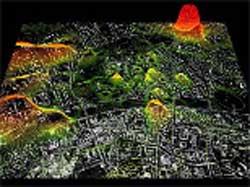MIT researchers map city by cellphone

Street map of Graz, Austria, overlaid with an electronic visualization of cellphone activity.
Can you see me now?
Researchers at MIT may not be able to hear your cellphone call, but they have found a way to see it. They mapped a city in real time by tracking tens of thousands of people traveling about carrying cellphones.
Using anonymous cellphone data provided by the leading cellphone operator in Austria, A1/Mobilkom, the researchers developed the Mobile Landscapes project, creating electronic maps of cellphone use in the metropolitan area of Graz, Austria, the country’s second-largest city.
The researchers used three types of data — density of cellphone calls, origins and destinations of the calls, and position of users tracked at regular intervals — to create computer-generated images that can be overlayed with one another and with geographic and street maps of a city to show the peaks and valleys of the landscape as well as peaks in cellphone use.
“For the first time ever we are able to visualize the full dynamics of a city in real time,” said project leader Carlo Ratti, an architect/engineer and head of the SENSEable City Laboratory at the Massachusetts Institute of Technology. “This opens up new possibilities for urban studies and planning. The real-time city is now real: a system that is able to continuously sense its condition and can quickly react to its criticalities,” he added.
In recent years, techniques to locate and track mobile devices have become increasingly available; such techniques were crucial to law enforcement officials in their investigation of the Madrid and London terrorist bombings. MIT’s Mobile Landscapes project takes advantage of these techniques at an unprecedented scale by mapping an entire urban region continually at regular intervals.
The continuously changing electronic maps, which have a surprising aesthetic appeal, will be displayed at the M-City Exhibition at the Kunsthaus Graz from Oct. 1 to Jan. 8. Visitors to the show will be invited to participate in the electronic tracking by sending text messages to a server. “This participatory act aims to engage them in the issues of social networks and distributed interaction, but also on the possible drawbacks of limited privacy and geographical surveillance,” Ratti said.
The research could also have implications for use in large-scale emergencies and for transportation engineers seeking ways to better manage freeway traffic.
In addition to Ratti, designers on the project include MIT graduate students Daniel Berry, Sonya Huang, Xiongjiu Liao, Andrea Mattiello, Eugenio Morello and Andres Sevtsuk, and sophomore Daniel Gutierrez, senior David Lee and junior Jia Lou. The exhibition is funded by A1/Mobilkom, which provided data and technical assistance to MIT’s SENSEable City Laboratory.
Media Contact
More Information:
http://www.mit.eduAll latest news from the category: Information Technology
Here you can find a summary of innovations in the fields of information and data processing and up-to-date developments on IT equipment and hardware.
This area covers topics such as IT services, IT architectures, IT management and telecommunications.
Newest articles

High-energy-density aqueous battery based on halogen multi-electron transfer
Traditional non-aqueous lithium-ion batteries have a high energy density, but their safety is compromised due to the flammable organic electrolytes they utilize. Aqueous batteries use water as the solvent for…

First-ever combined heart pump and pig kidney transplant
…gives new hope to patient with terminal illness. Surgeons at NYU Langone Health performed the first-ever combined mechanical heart pump and gene-edited pig kidney transplant surgery in a 54-year-old woman…

Biophysics: Testing how well biomarkers work
LMU researchers have developed a method to determine how reliably target proteins can be labeled using super-resolution fluorescence microscopy. Modern microscopy techniques make it possible to examine the inner workings…





















